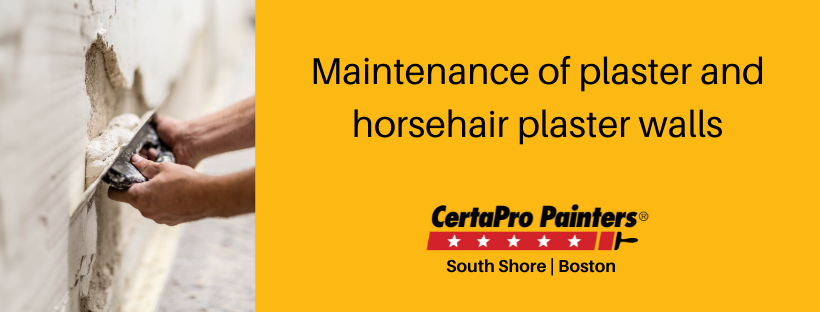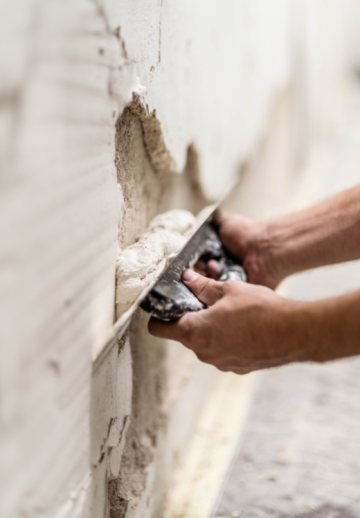
Repair and maintenance of Horsehair Plaster walls:
Posted on June 3, 2021

What is horsehair plaster?
Horsehair plaster is commonly used in older South Shore and Boston-area homes and is comprised of lime, aggregate, and sometimes animal hair. Homebuilders used horsehair in the early 1900s to bind the plaster mixture together and add strength. Underneath all types of antique plaster, you’ll find closely spaced strips of wood nailed to the studs called “lath.” The wood lath has spaces between them that help the mortar and plaster layers “grip” the wood while drying.
Can horse hair walls be repaired?
 Yes, holes and imperfections in the horsehair plaster can be filled with joint compounds. Larger holes can be repaired by cutting out the degraded plaster, fitting a piece of blue board in the hole, and then using plaster or joint compound to blend the repaired hole. Some homeowners like their horsehair plaster walls’ divots, imperfections, and uneven looks. If you repair holes in plaster walls, ensure these patches are completely dry before paint is applied. If the joint compound or underlying plaster is not dry before painting, the paint is likely to peel. You can tell the repaired area of plaster is dry when there are no dark patches on the wall, and the plaster repair has turned lighter.
Yes, holes and imperfections in the horsehair plaster can be filled with joint compounds. Larger holes can be repaired by cutting out the degraded plaster, fitting a piece of blue board in the hole, and then using plaster or joint compound to blend the repaired hole. Some homeowners like their horsehair plaster walls’ divots, imperfections, and uneven looks. If you repair holes in plaster walls, ensure these patches are completely dry before paint is applied. If the joint compound or underlying plaster is not dry before painting, the paint is likely to peel. You can tell the repaired area of plaster is dry when there are no dark patches on the wall, and the plaster repair has turned lighter.
How to repair horsehair plaster walls:
Filling holes in horsehair plaster is an easy do-it-yourself project:
- First, gather a putty knife, a trowel, plaster of Paris, water, sandpaper, and a paintbrush.
- Use the putty knife to scrape off any loose or flaky plaster from the hole’s edges. This will help create a smooth surface for the repair.
- Mix the plaster of Paris with water according to the manufacturer’s instructions. The consistency should be thick but spreadable.
- Use the trowel to apply the plaster of Paris mixture to the hole, smoothing it out as you go. It is important to apply the plaster evenly and ensure it fills the hole completely.
- Once the plaster has dried, use sandpaper to smooth out the surface and blend it in with the surrounding wall. You can tell the plaster has dried when there are no dark patches on the wall and the plaster of Paris has turned lighter.
- Finally, use a paintbrush to apply a coat of paint to the entire wall.
- We recommend repainting the entire wall (not just the newly plastered holes). Unless you have the exact paint used to paint the wall originally, it makes sense to repaint the entire wall to avoid it from looking spotty.
Can I paint my horsehair and plaster walls?
Yes. A latex primer and two light coats of flat latex wall paint are used to paint horsehair plaster walls.
What paint sheen should I use on my plaster walls?
Using a flat paint sheen (as opposed to a glossier sheen) on the plaster walls keeps the plaster looking most authentic. Also, flat paint will hide rough imperfections in the plaster. Conversely, using paint sheens like eggshell and satin can help highlight the plaster’s imperfect craftsmanship by adding a glossier and more light-reflecting surface.
How to remove wallpaper coverings from horsehair and plaster walls:
If you have wallpaper covering your horsehair plaster walls and want to remove the wallpaper, you must steam it off. Do not score the wallpaper because you could gouge and damage the underlying horsehair plaster or even cause it to crumble. Scoring the wallpaper also risks exposing you to potentially toxic plaster dust. You also cannot use harsh solvents to dissolve the wallpaper glue because doing so could also dissolve the plaster compound.
Can I drywall over horsehair plaster?
Yes, as long as the plaster is firmly bound to the wooden lath beneath it, sheetrock can be directly bonded to the plaster surface using a dot and dab method.
Why was horsehair added to plaster?
The purpose of adding animal hair to the plaster mixture was as a bridging agent. When the lime mixture was applied to the wooden lath, small points formed in plaster, creating a nib that helped the mixture stick to the wood lathing. Animal hair helped to bridge the nibs together and added to the strength and longevity of the plaster. The animal hair also helped reduce the shrinkage of the plaster. Before the automobile’s arrival, the horse’s hair was plentiful, and because the horsehair was long and strong, it made a good choice for this application.
Horsehair also acted as an insulation in older homes.
Is horsehair plaster used to build modern homes?
No horse hair plaster has been replaced with a more modern plastering technique where blue board (a type of gypsum board) is installed on the studs, the seams are taped, and a layer of plaster is troweled onto form a Jin plaster coating that is smoother and harder than drywall. This more modern method of installing plaster walls is seen in many upscale homes on the South Shore.

Should I keep my horsehair plaster walls or replace them with sheetrock?
This is a personal choice. Many of our Clients like to preserve and repair their older horsehair plaster walls to remain historically authentic. If you live in a house built before the 1940s, you likely have plaster walls, and as long as the plaster is in good shape, it usually makes sense to keep them.
Removing horsehair plaster walls is messy and costly. Plaster dust is tough to contain, and homeowners report finding plaster dust in places years after the plaster walls have been removed. Also, studs in old homes tend to be uneven, so even after removing the plaster wall, you may find the studs unsuitable for drywall installation. Horsehair plaster walls are handmade, so they are not perfect, adding to the home’s handcrafted feel.
Plaster is easy to contour, providing delicate archways and lovely curves, especially around windows and entrances. Drywall is less able to be contoured in this way because it is too rigid, so homes with drywall tend to have primarily rectangular angles.
Reasons to remove a plaster wall:
The reasons to remove a horsehair plaster wall can include the following:
To install insulation into outside walls, removing the horsehair plaster walls is often necessary. Homes with horsehair plaster walls tend to be poorly insulated, and we often see very primitive forms of insulation behind the plaster, such as newspaper and hay.
If your home is drafty and uninsulated, it may make sense to remove the horsehair plaster, insulate the outside walls using modern insulation, and reconstruct the exterior walls using drywall. Adding insulation usually occurs on only the exterior walls of your home, so you can leave your interior plaster walls intact.
Since the exterior walls tend to be rectangular anyway, using drywall after you insulate the exterior walls won’t harm the home’s charm – you can keep the charm by keeping the interior plaster walls with their curves and imperfections.
Interestingly, a plaster wall without insulation has twice the R-value (a measure of how well a material is insulated) than an uninsulated wall made of drywall or sheetrock. However, homes with outer walls made of drywall are more likely to be well-insulated than plaster walls.
Converting an older home to an open-floor plan or changing the room configurations, homeowners often take down horsehair plaster walls.
If a horsehair wall is in disrepair, it’s sometimes easier to remove the whole wall and replace it with sheetrock or modern plaster walls.
If a homeowner is updating HVAC, electrical, cable, or ethernet wiring in a home with horsehair plaster walls, the snaking of new wire and piping can be difficult or impossible behind a horsehair plaster wall because it is very little or no space in which to snake the wires.
Is horsehair plaster dangerous? Does horsehair plaster contain asbestos?
Horsehair plaster and dust can be potentially dangerous because they may contain asbestos and anthrax spores. If you brush the plaster, you risk exposing yourself to the plaster dust and these spores. Homes with darker horsehairs in the plaster tend to be safer, but lighter fibers in your plaster walls indicate a more likely presence of asbestos. The best way to determine if your plaster walls contain asbestos is to have them professionally tested.
For people allergic to animal hair, horsehair plaster is not the best environment to live in and could trigger allergy symptoms.
< BACK TO OUR INDEX OF ARTICLES, TIPS, AND ADVICE
You may also like to read:
Colors to Paint Your Historic Home
Our portfolio of recent painting projects





